The abundant tourism assets in the Middle East for regional promotion Sustainable tourism development seminar for the Middle East region(Oct. 4 to 26,2012)
This seminar was implemented from Oct. 4 to 26, with the aim of learning about sustainable tourism development involving the region’s residents by citing case studies from Japan and invigorating the Middle East region. Continuing from the same themes from seminars conducted from fiscal 2008 to 2010, the seminar was part of a new three-year plan that began in fiscal 2011. This seminar marked the second year of that plan.
A large number of case studies of regional tourism promotion were incorporated into the seminar program, so that it was not limited to lectures related to Japan’s tourism promotion policies, etc. A tourism course was made into a practicum, providing the participants with direct experiences while they exchanged opinions with volunteer tour guides and various people from regional areas. The seminar created the opportunity to receive responses directly from tourists and residents of the region. Below we introduce case studies from various locations in Japan that were visited during seminars and the activities of seminar participants who have returned home.
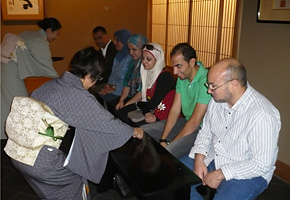
tea ceremony experience featuring the hospitality of the Suimeikan Inn in Gero, a hot spring resort
This seminar had the theme of “sustainable tourism development,” and it was a form of tourism promotion by mainly local residents. The participants learned various case studies taken from around Japan. In the backdrop of initiatives like those in Japan, many cases of community preservation were endangered by the graying population together with a low birthrate, depopulation, etc. On this point, with its high birthrates and a younger generation making up a high proportion of the population, the Middle East region has somewhat different conditions. But with respect to the kind of roles that should be played by regional communities, local governments and the private sector for the sake of regional promotion through tourism, the seminar participants were kindly introduced at various places on their trips, and we were able to provide them with the opportunity to consider and learn about the issues.
In addition, we heard reports from participants who have returned home, explaining their activities and citing case studies from Japan. Now we introduce some feedback from participants in seminars last year from Lebanon and Palestine.
Osaka Monozukuri Kanko Suishin Kyokai (Tourism Promotion Association) and JR West Japan
Osaka Monozukuri Kanko Suishin Kyokai, a general incorporated association, the representative body of which is Hotel Seiryu in Higashi Osaka City, which aims to be an inn that loves the local area and is loved by the local area, promotes activities together with JR West Japan. With the mottos of “We want people to know and to learn about the monozukuri spirit and monozukuri commitment,” two organizations tell school students about monozukuri (manufacturing) at various neighborhood factories in Higashi Osaka and has the role of being a contact point. The main targets are students on educational field trips and school excursions.
These activities have seen visible and steady results in the form of rising student numbers. Along with being introduced on numerous occasions on TV programs, the activities have been widely acclaimed, such as being selected in 2010 as a project eligible for assistance by the Ministry of Economy, Trade and Industry as a “broad and comprehensive tourist attracting service support activity” and the Excellence Prize at the 7th JTB Exchange Culture Award in January 2012. Recognition of these activities continues to spread far and wide.
Even small local factories producing machinery parts, facilities assumed not to have any connection with tourism, attracted the keen interest of the seminar participants, who listened carefully to their lecturers. They heard how about the factories’ ability to become tourism assets through their readiness to receive tourists and PR innovations.
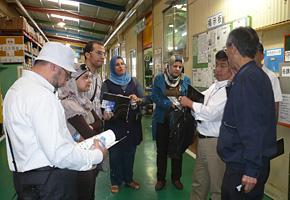
A field trip to Fujiseisakusho Co. in Higashi Osaka
Gero City, Gifu Prefecture
Gero is well known as one of Japan’s three famous hot springs. On the theme of rejuvenating tourism sites, we heard from President Taki of the Suimeikan, a local traditional inn, about centralized management of hot-spring resources, energy saving measures at the accommodation facilities and other efforts by the innkeepers’ association. The seminar participants were able to experience the hospitality of a hot spring inn in a Japanese-style room that conveys Japan’s traditions, as they were treated to a tea ceremony, kaiseki cuisine and the hot spring. On the following day, in Osaka, Gero City, they visited the Osaka Waterfalls, which received a No. 1 certification in 2008 for being a “Treasure of Gifu,” and is a source of hometown pride for the people of the prefecture. (The waterfalls were formed 54,000 years ago through lava flows, which creating more than 200 of them.) Director Katsuragawa of the NPO Hida Osaka 200 Waterfalls kindly introduced how systems were created and courses were prepared that guide people around the environment and also activities linked to regional promotion, while continuing to preserve the natural environment. He allowed the participants to take an on-site field trip that was modeled on a course about waterfalls. A participant from Egypt, which has little tourism in its provincial cities, said, “Egypt also has hot springs, in its desert and oases, but they aren’t used very much. The talk about centralized management and other issues will serve as a good reference for me.”
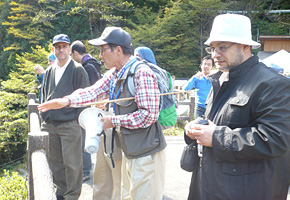
Seminar participants experience a genuine field-trip course at Osaka, Gero City.
Kyoto Cycling Tour Project
The Kyoto Cycling Tour Project (KCTP) was established 10 years ago in Kyoto with the aim of “promoting cycling tourism.” Its activities to date have involved supporting cycling tourism for a total of over 350,000 tourists, with cycling tours that provide rental bicycles and guides. The service enjoys a high level of popularity from foreigners, who can make reservations on its easy-to-understand homepage that handles six languages. The seminar participants were also impressed by the project’s attention to detail, such as its thoroughly established bicycle maintenance service and production of tourism maps of Kyoto, which show original model courses that emphasize accessibility by bicycle.
After listening to the lecturers in the morning, the participants took up the challenge of genuine cycling tourism. In the Middle East region, students use bikes to get to school, but once people become adults, they hardly ever use bicycles as a means of getting around. The participants said, “It’s been a long time,” as the tour got under way. Not one of them dropped out, even as they huffed and puffed, and they managed to complete the more than two-hour long tour. Although some of the seminar participants seemed to be a bit tired, they did appear to be fully satisfied from a sense of accomplishment by freely enjoying Kyoto’s charms, which could only seen from the saddle of a bicycle, and the novel way of travel.
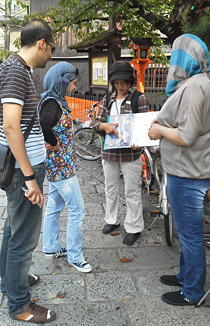
In the Gion district of Kyoto. The participants experienced a distinctive tour of Kyoto.
Action reports from participants who attended seminars in fiscal 2011
Lebanon
Plans for a trekking tour
Ms. Zeina HADDAD
Head of Jeita and Grottos Department,Tourism Development Division,Ministry of Tourism
We have prepared guesthouses in a number of Lebanese villages that offer regional cuisine and other features, and we are moving forward with our plans for tours (the Lebanon Mountain Trail Project) in which tourists can enjoy trekking while also becoming intimate with the land’s culture, history and nature. Already, we have been able to put in place a system to offer monitoring tours aimed at tourism-related companies and public-sector officials. In addition, we presented this initiative to delegates from various countries at an international conference in Brussels, Belgium, to consider sustainable tourism development.
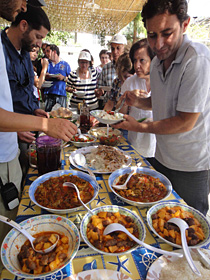
People experience regional cuisine at guesthouse during a monitoring tour.
Palestine
Creating picture books of the preservation of historical remains
Mr.Iyad A. A. HAMDAN
Director, Jericho Office, Tourism and Antiquities Division, Ministry of Tourism and Antiquities
During the seminar in Japan, I set up an action plan that expanded public-awareness activities for children for the problem that awareness about the importance of historical remains and their preservation had not filtered through to the people, children in particular. After I returned home, based on that idea, I created picture books that conveyed to children the importance of preserving the remains, and I distributed the books to various libraries with the cooperation of JICA’s office in Palestine. Furthermore, I have been going to summer camps exclusively for children where I have been actively expanding public awareness while using the picture books.
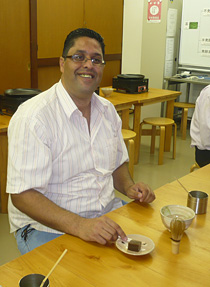
Mr.Iyad during his seminar in Japan.


